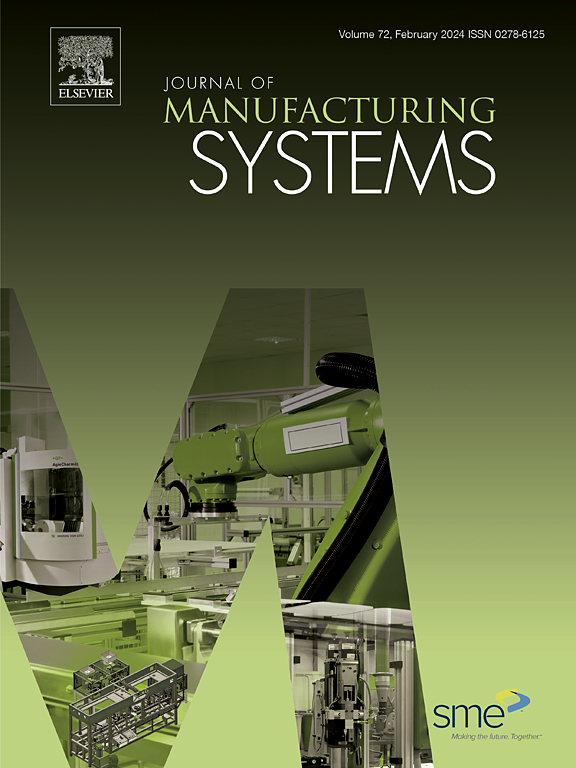基于物理信息与CNN融合的复杂薄壁零件加工误差监测方法
IF 14.2
1区 工程技术
Q1 ENGINEERING, INDUSTRIAL
引用次数: 0
摘要
复杂薄壁零件的加工误差直接影响到产品的质量和性能,因此对其进行监测至关重要。对此类零件加工误差的监测往往依赖于相关的物理信息。然而,时变物理信息受测量系统动态响应的影响,并且物理信息与加工误差之间的空间动态关系非常复杂,给监测带来了重大挑战。针对这些问题,提出了一种基于物理信息与卷积神经网络(CNN)融合的复杂薄壁零件加工误差监测方法。首先介绍了一种基于物理理论的TVPI识别方法,提取切削力谱幅值作为TVPI,用于监测加工误差;然后利用CNN的特征提取和非线性回归建模能力对物理信息进行智能过滤,学习物理信息与加工误差之间的复杂关系。最后,提出了一种基于物理信息与CNN融合的加工误差监测方法,并在叶片等复杂薄壁零件上进行了实验验证。与传统特征识别方法相比,TVPI识别方法具有更强的物理可解释性。此外,物理信息与CNN的融合显著提高了监测性能。与基于高斯过程回归、深度神经网络和长短期记忆的监测方法相比,基于物理信息与CNN融合的监测方法的RMSE至少降低了21.74 %。该方法不仅为复杂薄壁零件的加工误差提供了有价值的反馈,而且为后续加工策略的优化和调整提供了技术支持。本文章由计算机程序翻译,如有差异,请以英文原文为准。
A method for monitoring machining errors of complex thin-walled parts based on the fusion of physical information and CNN
Machining errors of complex thin-walled parts have a direct impact on product quality and performance, making their monitoring essential. The monitoring of machining errors of such parts often depends on relevant physical information. However, time-varying physical information (TVPI) is influenced by the dynamic response of the measurement system, and the spatial dynamic relationship between the physical information and machining errors is highly intricate, posing significant challenges for monitoring. To address these challenges, a method based on the fusion of physical information and Convolutional Neural Network (CNN) is proposed for monitoring machining errors of complex thin-walled parts. Initially, a TVPI identification method based on physical theory is introduced, and the spectrum amplitudes of cutting forces are extracted as the TVPI for monitoring machining errors. The feature extraction and nonlinear regression modeling capabilities of the CNN are then leveraged to filter the physical information intelligently and learn the complex relationship between the physical information and machining errors. Ultimately, a monitoring method for machining errors based on the fusion of physical information and the CNN is proposed and experimentally validated on complex thin-walled parts such as blades. Compared with traditional feature identification methods, the TVPI identification method provides enhanced physical interpretability. Additionally, the fusion of physical information and the CNN notably improves the monitoring performance. Compared with monitoring methods based on Gaussian Process Regression, Deep Neural Network and Long Short-Term Memory, the monitoring method based on the fusion of physical information and the CNN results in at least a 21.74 % reduction in the RMSE. The method not only provides valuable feedback on machining errors of complex thin-walled parts but also offers technical support for the subsequent optimization and adjustment of machining strategies.
求助全文
通过发布文献求助,成功后即可免费获取论文全文。
去求助
来源期刊

Journal of Manufacturing Systems
工程技术-工程:工业
CiteScore
23.30
自引率
13.20%
发文量
216
审稿时长
25 days
期刊介绍:
The Journal of Manufacturing Systems is dedicated to showcasing cutting-edge fundamental and applied research in manufacturing at the systems level. Encompassing products, equipment, people, information, control, and support functions, manufacturing systems play a pivotal role in the economical and competitive development, production, delivery, and total lifecycle of products, meeting market and societal needs.
With a commitment to publishing archival scholarly literature, the journal strives to advance the state of the art in manufacturing systems and foster innovation in crafting efficient, robust, and sustainable manufacturing systems. The focus extends from equipment-level considerations to the broader scope of the extended enterprise. The Journal welcomes research addressing challenges across various scales, including nano, micro, and macro-scale manufacturing, and spanning diverse sectors such as aerospace, automotive, energy, and medical device manufacturing.
 求助内容:
求助内容: 应助结果提醒方式:
应助结果提醒方式:


